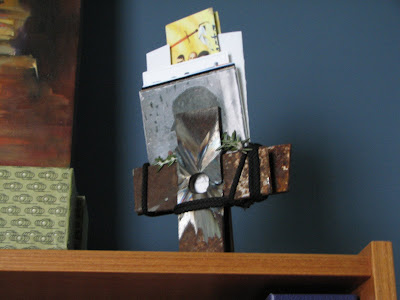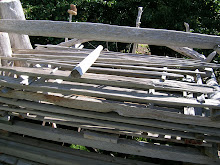
Returning to the realm of the object,
Sometimes rust connects one element to the next in a set. Rust reveals aging metal. It changes the surface and sometimes interrupts function. Sometimes the surface becomes so pocked and darkened the object takes on a whole different beauty. Irgun resides here, an African spirit of iron, strength and integrity. I often think of Irgun respectfully and playfully when I find discarded pieces of metal that wear lines of nature. It inspired a definition of art as any object that engaged the imagination because of the signs of human handiwork amid nature’s handiwork.
At first I called these transformations simply substitutions. In a set of objects we can playfully substitute one item for another more predictable item. Sense humor? Much of my recent play involves simple placements and replacements. Open a suitcase; find lots of kitchen aluminum “Jello” molds and a damask pillowcase, and two small nutmeg graters, an enamel strainer and a sturdy aluminum bowl. What happens here?
When we add an unexpected weathered found object into an assemblage, the ordering mind takes hold of the order and tries to include the altered object.
Nature loves to distort objects.

The Japanese aesthetic of Wabi Sabi:
[space/time...spirit/matter...
subject/object... construct/ideal…
(misery of living alone in nature away from society/cheerless...chill/worn/withered...)
more/less]
formalized this natural weathering as part of a 14th century tea ceremony. No other aesthetic draws in my heart and creative impulse, as does Wabi Sabi. It allows players like myself to take any discarded natural or man-made object and value it for the natural signature that it bears. In my imaginary realm nature has played with the substance and offered it back to me charmed, saying come decipher the wonder of existence. Sometimes the object humorously and exquisitely presents itself, so that I simply want to contain it in my hand or nest it in a container and share it with others.
Consider: a found flattened glue can lid with attached brush. A rusted remnant from contact cement. School projects art class circa. 4th grade.
As some objects unravel, they reveal aspects of their integrity we’ve forgotten or never knew. Sometimes they remind me of archeological finds, displayed for the curious. Now I can create a whole set of weathered objects and also add an unused object to heighten awareness of the transformation.
At one point in my life, plastic deeply offended me. I still resent the litter. But in the game of life some offensive behaviors don’t resolve simply by our outrage. I began to notice the colors that plastic takes on as it degrades. I’ve even found enchantment in some of the shapes, colors and surface textures. In a recent fire one of the few consolations were the melted plastic forms flowing along surfaces. Almost dripping off, or pooling. Some times the name brand or logo of an altered object stimulates amazement. It gives an anti-commercial message.
Transformation Exercise#5: Litter Poem
Collect three or four usual items, which once held familiarity. Collect them from the back of your kitchen drawer or from your closet or garage. Collect them from litter in the neighborhood. Combine them in a single form to make a little physical haiku. Words can mark the surface or marks can just fill the surface wordlessly. If inspired, these little totems can occupy places to remind others not to litter. Imbue the object with this intent, if so inclined. Or place some other intent in the totem and place it, appropriately according to that intent out in the community. If anyone asks about it, elaborate the intent. Let it serve as an elaborate community outreach program to end littering. Don’t worry; when the world suddenly becomes litter free, we’ll still have plenty of things with which to play.
I have a large greased bolt and a small aluminum wire wrapped around the bolt’s thread. The other end of the wire wraps around a small sycamore branching section. Another darker thin twig balances on a hole in the washer around the bolt. The whole assemblage sits perched at the edge of a shelf, posed for flight or tumbling folly. Three lines for my Haiku: the bolt, the wire, the branching wood pieces.
 “Where does this go?” I wrote in the margin. The margin tempts the page to have an extended edge, a river of open space that exists in parallel to the page. In all my attempts to include margin notes, do I try to dissolve the edge of the page so that another story blends into this experience? Some readers quietly delight to resolve the duality of the printed page and the margin with margin notes of the thoughts evoked while reading. It could even be marks, lines and squiggles. Still others might resolve this quite differently. The invitation stands.
“Where does this go?” I wrote in the margin. The margin tempts the page to have an extended edge, a river of open space that exists in parallel to the page. In all my attempts to include margin notes, do I try to dissolve the edge of the page so that another story blends into this experience? Some readers quietly delight to resolve the duality of the printed page and the margin with margin notes of the thoughts evoked while reading. It could even be marks, lines and squiggles. Still others might resolve this quite differently. The invitation stands.  Maybe I do need a point of view ad absurdum. Comparing apples and oranges. Like not favoring universal heath care because of the level of abuse. That’s a given in any social system where education is lacking, and scarcity promoted. The right to equal care in a wealthy country should not be negotiable. One is an apple the rest are oranges. The arguments are absurd decoys of reason. We fail each other. I’m sorry.
Maybe I do need a point of view ad absurdum. Comparing apples and oranges. Like not favoring universal heath care because of the level of abuse. That’s a given in any social system where education is lacking, and scarcity promoted. The right to equal care in a wealthy country should not be negotiable. One is an apple the rest are oranges. The arguments are absurd decoys of reason. We fail each other. I’m sorry.
































